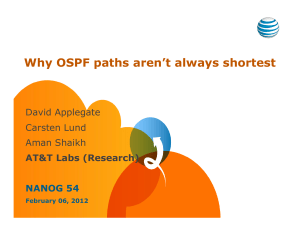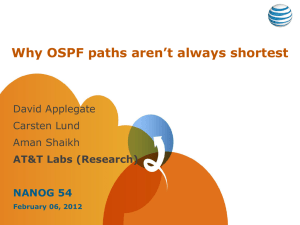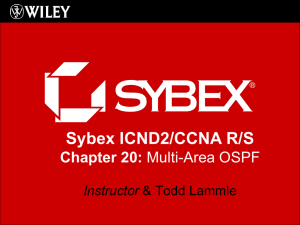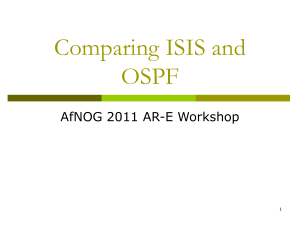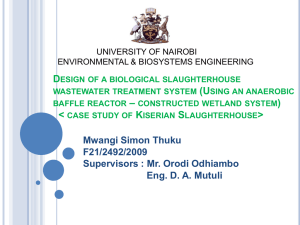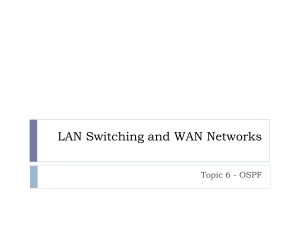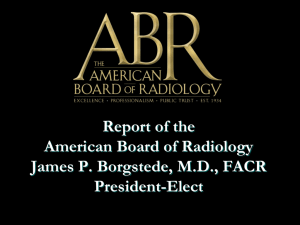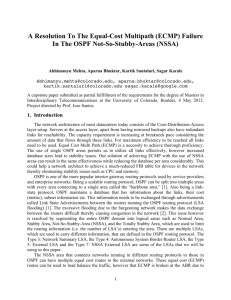Interesting Things to do with OSPF
advertisement
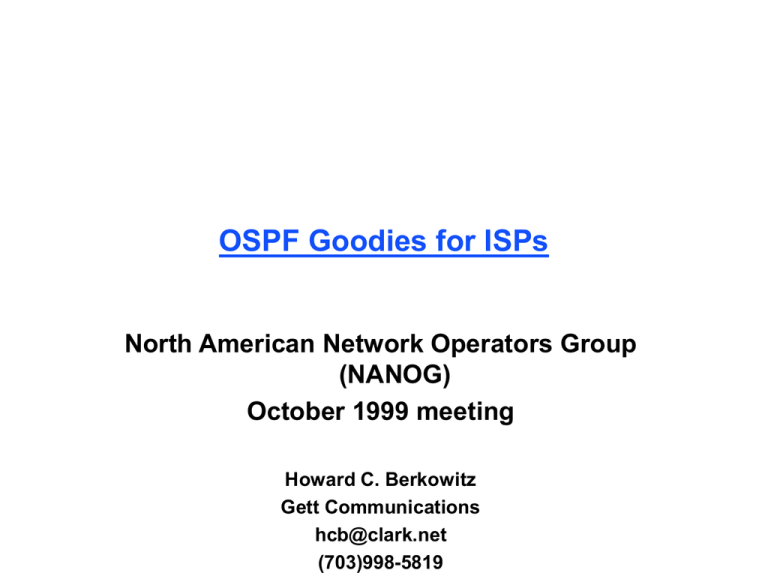
OSPF Goodies for ISPs North American Network Operators Group (NANOG) October 1999 meeting Howard C. Berkowitz Gett Communications hcb@clark.net (703)998-5819 The Past • Version 1 – RFC 1131 IETF Proposed Standard • Version 2 – RFC 1247 IETF Proposed Standard – RFC 1583 IETF Draft Standard • RFC 1812 requires OSPF for dynamic routing • And things progressed... The Near Term • RFC 2178 – Still at Draft Standard level; still Version 2 – Enhancements • • • • NSSA Demand Circuits OSPF over Frame Cryptographic authentication – TOS routing removed • RFC 2328 – Full Standard The Standards Future • OSPF Version 6 – Originally intended for V6 only – Made dual capable for V4 and V6, and possibly other protocols such as IPX – Generally upward compatible • better scalability for Multicast OSPF • quality of service routing – Internet Draft OSPF and Single Areas An Area has... • Am area ID • A set of address prefixes – Do not have to be contiguous – So a prefix can be in only one area • A set of router IDs – Router functions may be interior, inter-area, or external Areas and Performance • General workload for routing: O(Prefixes) • In general areak structure, workload per router: O(x): "on the order of x" O(Prefixesk + InjectedExternalsk) • In OSPF areak, workload per router: O((Prefixesk + InjectedExternalsk)) + log(Routersk) Area Sizing Guidelines • Rules of thumb for non-backbone area – No more than 100 routers – No more than 50 neighbors per router • Decrease when media unstable – Consider static/default and demand techniques • Decrease when large numbers of externals injected – Consider if the incoming externals can be summarized or filtered When Might Single-Area OSPF make sense? • Fewer than 50 routers with alternate paths • Needs: – – – – multivendor compatibily fast convergence VLSM complex defaults and externals • No clear candidates for core – OSPF power greatest with hierarchy – Multiple domains may be better than 1 area – EIGRP a possible alternative How Many Areas? • Map communities of interest (COI) to areas • Add COI until number of routers exceeded • Avoid >2-3 areas per ABR unless very stable • Watch CPU loading in ABRs • Numbering easier if #areas is power of 2 SIngle-Domain Inter-Area Basic Inter-Area Area 0.0.0.0 Area 0.0.0.1 Area 0.0.0.2 Note ABR servicing multiple nonzero areas. Rule of thumb -- not more than 3 nonzero areas Area 0.0.0.3 ISP OSPF 1: Implementation Area 0.0.0.0 Mgt POP 1 Area 0.0.0.1 POP 2 Area 0.0.0.2 POP 3 Area 0.0.0.3 POP 4 Area 0.0.0.4 Server Farm Area 0.0.0.5 The Right Reason to Break Hierarchy Traffic management, not “redundancy” Domain 1 Area 0 OSPF flow for general traffic and backup Static route with AD < 110 for heavy traffic Summarization/Aggregation • Summarization – Reduces inter-area route workload – Configure manually on ABR • Aggregation – Reduces external route workload – Configure manually on ASBR – Complements stubby areas Multiple ABR Both ABRs advertise the same summary when summarization is configured Partitioned Nonzero Areas Area 0 X X Both ABRs still advertise the same summary when summarization is configured. Ooops! External Information Externals are a Good Thing • A way to learn about things outside your local system • Allow workarounds to some awkward configurations • Sources of externals include: – – – – Other OSPF domains Other IGPs: EIGRP, IGRP, RIP, IS-IS BGP-4 Static routes Multiple Homogeneous Domains Area 0 Domain 1 Area 1 Area 2 Area 3 Area 0 Domain 2 Area 1 Area 2 Multiple OSPF copies with different process ID Area 3 Multiple Heterogeneous Domains Area 0 Domain 1 Area 1 Area 2 Area 0 Domain 2 Area 3 Area 1 RIP domain Area 2 Static routes Note hierarchy! Area 3 Multiple Autonomous Systems Area 0 Domain 1 Area 1 Area 2 Area 3 BGP becomes involved Area 0 Domain 2 Area 1 Area 2 Area 3 Externals and Aggregation 1 • A full ISP routing table has approximately 62,000 routes – But will you do anything differently if you know all of them and have a single ISP? – Multiple ISP situations call for complex OSPF and BGP design • Never redistribute IGPs into BGP • Restribute BGP into IGPs with extreme care Externals & Aggregation 2 • In an enterprise – Limit externals from subordinate domains (e.g., RIP) • Flood only in area 0 and in area with ASBR – Allow externals from Internet, peer domains to go outside Area 0 • Only when there will be significant path differences • Do things with defaults where possible Type 1 and Type 2 externals • Type 2 – Default type for routes distributed into OSPF – Exit based on external cost only • Type 1 – Needs to be set explictly – Selects exit based on internal + external costs ASBR Placement Domain 1 Area 0 Domain 1 Area 1 Domain 1 Area 2 Contrary to common opinion…you can have ASBR outside area 0. Nonzero area with ASBR can’t be stubby or totally stubby ASBR Default Information 0.0.0.0 route routers outside this domain OSPF speakers in this domain LSAs router ospf OSPF generated routes Acceptance Policies Routing Information Base 0.0.0.0 external LSA default information originate router ospf OSPF and Default Routes OSPF Speakers Edge routers (note dual-homed default) Stubbiness: A Means of Controlling Externals Regular Area Specific internal, Summary external, Default Specific external Domain 1 Area 0 REGULAR REGULAR The idea of stubbiness • Reduce overhead in nonzero areas by reducing the number of externals • Stubbiness helps only if there are significant numbers of externals – But remember any redistributed route is external – Inside an OSPF domain, stubbiness does not help • External aggregation can help stubbiness • Inter-area summarization complements stubbiness & aggregation for internal routes Restrictions with Stub Areas • Stubby – Cannot have ASBR outside Area 0 – Potential problem during migration – Potential problem for multiple Internet attachment points • Totally stubbly – Single ABR; single point of failure – Cisco proprietary – Maximum traffic reduction • Not So Stubby – Can only know externals injected into it by local ASBR Stubby Area Specific internal, Summary external, Default Specific external Domain 1 Area 0 STUB REGULAR Totally Stubby Area Specific internal, Summary external, Default Specific external Domain 1 Area 0 TOTALLY STUBBY REGULAR Not So Stubby Area Specific internal, Summary external, Default Specific external Domain 1 Area 0 REGULAR NOT SO STUBBY Totally Stubby and also Not So Stubby Specific internal, Summary external, Default Specific external Domain 1 Area 0 REGULAR NOT SO STUBBY Redistribution Redistribution = Acceptance sources of xxx information redistribute xxx under router ospf External LSAs OSPF speakers router ospf (applies default metric) Acceptance Policies Routing Information Base Hierarchical Redistribution Core: OSPF or EIGRP dynamic routing Full routes from local domain (except default) Local Full use, Routes legacy, etc. Protocols Default route only X Local use, legacy, etc. Protocols Loop-free and easy to configure Can use multiple routers Basic Mutual Redistribution Default 2 Default 1 Local use, legacy, etc. Protocols Local use, legacy, etc. Protocols Manual configuration usually needed to prevent loops Single redistributing router makes it much simpler But is a single point of failure Mutual Redistribution Multiple Redistribution Points Local use, legacy, etc. Protocols Local use, legacy, etc. Protocols Extensive configuration usually needed to prevent loops No single point of failure Very hard to troubleshoot OSPF and Default Routes • OSPF convention – 0.0.0.0/0 (subnet mask 0.0.0.0) – Treated as external – May have different defaults in different areas • Blackhole routes give pseudo-default An Application of Blackhole Routes Inside the Dial Server OSPF Process redistributes static ip route 192.168.0.0 255.255.255.0 null0 192.168.0.1/30 192.168.0.5/30 • • • 192.168.0.252/30 Complex and Useful Domain Relationships A Trap to be Avoided: Overemphasizing Area 0 • A given domain has only only one Area 0 • But if there are scaling problems in a domain... • Use multiple domains – Each with their own Area 0 – Connecting to other OSPF and non-OSPF domains via ASBRs • Use appropriate extensions – Virtual links – ASBRs outside Area 0 • NSSAs a powerful new extension Access to Single ISP Closest-Exit Load Sharing, No BGP Needed ISP 1 Static routes D1-A0 ASBR1 D1-A0 ASBR2 Default Route (0.0.0.0/0) Metric Type 1 Equal Metrics Single ISP Link-Level Load Balancing ISP 1 Static routes D1-A0 ASBR1 Default Route (0.0.0.0/0) Metric Type 1 Equal Metrics Access to Primary & Backup ISP ISP 1 POP ISP 2 POP Static routes D1-A0 ASBR1 D1-A0 ASBR2 Default Route (0.0.0.0/0) Metric Type 2 Higher Metric to ISP 2 (Backup) Internet Access with Exception Case Upstream Distribute List blocking 0.0.0.0 towards Area 0 Permits all other LSAs ISP 1 POP D1-A0 ASBR D1-A1 ABR Static route General default route from Area 0 D1-An ABR Downstream Distribute List blocking 0.0.0.0 towards Area 1 Special Area ISP 2 POP D1-A1 ASBR Other Areas RIP Migration OSPF Area 0 D1-A2 ABR D1-A1 ABR D1-A1 ASBR OSPF routing processes redistribute rip routes except 0.0.0.0 injects all/part into Area 0 know about RIP routes associated with their area OSPF Area 0 routing aware of all OSPF & RIP generated routes D1-A2 ASBR RIP routing processes RIP 1 redistribute 0.0.0.0 RIP 2 from OSPF into RIP unaware of other RIP domains Backbones of Backbones Default origination Domains have clean addressing; static routes between s0 s1 s0 s1 s0 s1 Area 0 Area 0 Area 0 ABR ABR ABR ABR ABR ABR ABR ABR ABR Domain 1 (D1) Domain 2(D2) Domain 3(D3) 171.16.0.0/16 171.17.0.0/16 171.18.0.0/16 iBGP linkage of enterprise routing domains AS1 s0 s1 s0 s1 s0 s1 Area 0 Area 0 Area 0 ABR ABR ABR ABR ABR ABR ABR ABR ABR AS1 AS1 AS1 Domain 1 (D1) Domain 2(D2) Domain 3(D3) 171.16.0.0/16 171.17.0.0/16 171.18.0.0/16 eBGP linkage of enterprise routing domains AS100 s0 s1 s0 s1 s0 s1 Area 0 Area 0 Area 0 ABR ABR ABR ABR ABR ABR ABR ABR ABR AS1 AS2 AS3 Domain 1 (D1) Domain 2(D2) Domain 3(D3) 171.16.0.0/16 171.17.0.0/16 171.18.0.0/16 For Additional Information • Current version of http://www.ietf.org/internet-drafts/ draft-ietf-ospf-deploy-00.txt draft-berkowitz-multirqmt-01.txt • Contact author for seminar information Books • H. Berkowitz: Designing Addressing Architectures for Routing and Switching (Macmillan 1998) • H. Berkowitz: Designing Routing & Switching Architectures for Enterprise Networks (Macmillan 1999) • T. Thomas: OSPF Network Design Solutions (Cisco Press, 1998) • J. Moy: OSPF: Anatomy of an Internet Routing Protocol. (Addison-Wesley, 1998)


